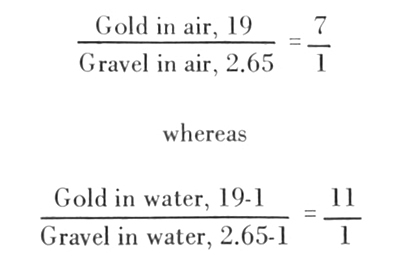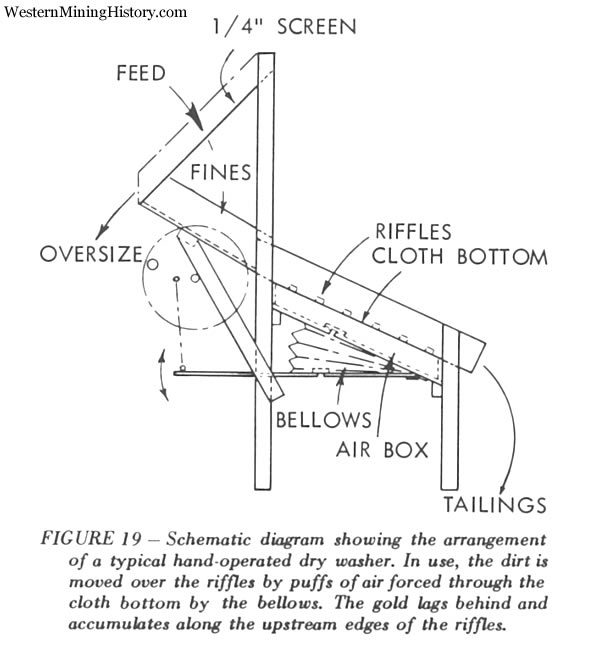6. SPECIAL MACHINES
A variety of small mechanical gold washers have been manufactured and put on the market over the years and although most were intended to be used for small-scale mining operations, some were advertised and sold as prospecting or sampling units. The typical machine consists of a small trommel screen with a feed hopper for shoveling in, a short sluice (which is usually provided with a shaking motion or some kind of "special" riffle), a pump, and a water distribution system, all run by a small gasoline engine. The typical machine weighs more than 500 pounds and requires a pickup truck or a trailer for transportation. Most are no longer manufactured and have passed from the scene but two of the better-known machins are still on the market.
These are manufactured by the Denver Equipment Company and known as the "Denver Mechanical Gold Pan" and the "Denver Gold Saver" respectively. The mechanical pan has been well received in the industry over a 30-year period and is generally referred to simply as a "Denver Pan." It comprises an assembly of three shallow, nested pans 2 feet in diamteter with two superimposed screens arranged to wash and reject the plus 1/4-inch material. The combined assembly is mounted on a horizontally gyrating base driven by a small gasoline engine and the resultant motion is said to duplicate hand panning. The minus 1/4-inch material after passing through the screens, progressively flows over the three pans, one discharging into the next. The uppermost pan is provided with an amalgamating plate, and the two successive pans with special rubber mats or cocoa matting held down by coarse wire screen. Capacity of a single unit ranges up to 2 cubic yards per hour and water consumption is said to be as little as 1 to 2 parts (by weight) per part of gravel which would indicate an average of about 1,000 gallons per cubic yard. Single or double units are available and these can be provided with a scrubber and a trommel-type screen. The largest (Duplex) unit when so equipped has a rated capacity of 4 to 6 bank-run yards per hour and weighs 2100 pounds. The single (Simplex) unit without the trommel weighs 675 pounds. The Denver Mechanical Gold Pan is sturdily built and is suitable for continuous use such as would be encountered in a mining operation.
The Denver Equipment Company's second machine, sold under the name of "Denver Gold Saver", is well suited for general sampling work in that it can be quickly and easily cleaned thus eliminating the danger of carry-over of values from one sample to the next. It consists of a feed hopper, a combined scrubber and trommel to wash and screen out the plus 1/4-inch material, a special vibrating molded riffle, a reserve water storage tank and a centrifugal pump with suitable piping sprays, etc., all powered by a 1 1/2 HP gasoline engine. The complete assembly weighs 750 pounds and has a rated capacity of 2 to 3 cubic yards per hour.
6. DRY WASHERS
In arid districts where water is scarce or expensive and a "dry" plant is proposed for the recovery of placer gold, a small dry washer may be the logical choice for processing samples. A number of small, hand-powered machines are on the market and most work quite well within certain limits common to all dry washers.
First, consider two identical gold particles, one in a dry washer and the other submerged in water. It will be shown that the relative weight of the dry gold particle is substantially less than its wet counterpart. This is illustrated by the following equations in which the specific gravity of gold is 19, the specific gravity of gravel 2.65, and the specific gravity of water is 1:

This shows the gold to be eleven times heavier than gravel when immersed in water, as compared to 7:1 in air. Simply stated - the relative weight of gold is about 1 1/2 times greater when passing through a wet process than when passing through a dry washer. The lesser ratio in air is not too apparent when processing coarse or "shotty" gold but it no doubt contributes to the dry washer's often poor recovery of fine or flaky gold.
To respond to dry washing the material treated must be almost completely dry. In most cases 3 percent moisture is considered a maximum. The gold particles must also he completely liberated and free of cementing material such as caliche. In addition, effective separation is usually dependent on use of a closely-sized feed, sometimes not larger than 1/4" screen-size. One might say that the amenability of a dry placer to working by the usual (dry) methods varies in proportion to its suitability to sizing by screening.
Besides the well-known difficulties related to drying placer material prior to dry washing and using small-mesh screens, there are other problems less generally appreciated. Wilson and Fansett (1961, p. 108) in referring to tests made at the University of Arizona sum these up by saying:
"A dry concentrator will not make as high recovery as a wet concentrator. Under favorable conditions, the recovery will be approximately ten to fifteen percent less with a dry machine as compared with a wet machine. "
This tells us that in cases where a dry processing plant is proposed for the recovery of gold in a commercial-scale placer operation, it might be advisable to process the initial samples with a small dry washer. Figure 19 illustrates a type of machine found suitable for this purpose. If all else is equal, the recovery obtained from the dry (sample) washer should indicate the recovery to be expected from the full-scale operation. On the other hand, if the samples are washed in a rocker or other wet device, a suitable recovery "correction" factor may have to be applied to the indicated sample values.

REFERENCES CITED (PART IV)
Wilson, Eldred D. and Fansett, George R., 1961, Gold placers and placering in Arizona: Arizona Bureau of Mines Bulletin 168 (1961).